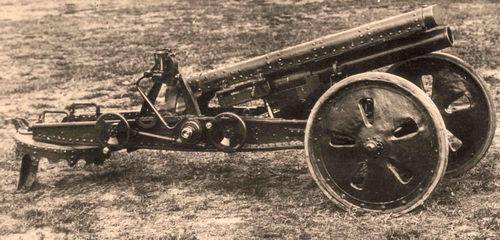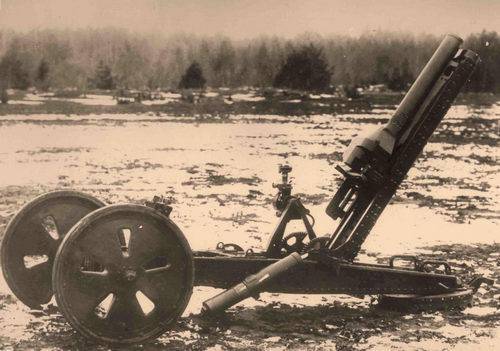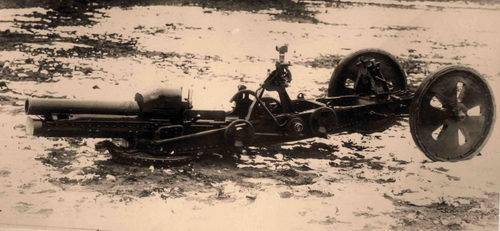Guns toys
Since the times of Emperor Paul I, who abolished the regimental artillery, and up to 1915, in the Russian infantry and cavalry division, the only weapons guns and sabers remained. Yes, absolutely seriously: in our divisions there was no other weapon and not a single very poor cannon. Another thing is that in the course of hostilities, an artillery brigade was attached to the division, the commander of which was transferred to the operational command of the division commander. In the course of the Napoleonic wars, when a large plain was chosen for battle, such a scheme worked well. But for the twentieth century, when the nature of warfare has changed radically, it is no longer suitable.

The X-NUMX-mm F-76 battalion cannon was manufactured in two versions. The first one was made at plant No. 23 at the end of 92 of the year. After 1936 shots on the prototype, there were cracks in the machine, and the system was returned to the factory for refinement.
Cannon Colonel Rosenberg
During the First World War, all sides quickly realized that dense columns of troops in an open field became an ideal target for the enemy. The infantry hid in the trenches, and for the attack began to choose rugged terrain. However, the troops still suffered heavy losses from the enemy machine guns, and it was difficult, even impossible in many cases, to suppress them with the help of a second-hand artillery brigade. Tiny guns were required, which could be located next to the infantrymen in the trenches, and when offensive they were easily transported or rolled manually by calculating from 3 – 4 people. They were supposed to destroy machine guns and enemy manpower.
The Rosenberg 37-mm cannon was the first Russian battalion of this kind. Colonel Mikhail Fedorovich Rosenberg, being a member of the Artillery Committee, persuaded the chief of artillery of Grand Duke Sergei Mikhailovich to give him the task of designing this system. Rosenberg with a team of assistants retired to his estate and after a month and a half presented the finished project 37-mm gun.
As the barrel of the Rosenberg system, an 37-mm standard supplementary stem was used, which served to fire coastal guns. The machine was a wooden, single-girder, tough (that is, without recoil devices). Partially, the recoil energy was extinguished by special rubber buffers. In this case, the machine had the simplest screw lifting mechanism, and the turning of the gun was done manually by the shooter by turning the trunk of the carriage. The machine was completed with a shield thickness of 6 or 8 mm. Moreover, 8-mm armor maintained a Mosin rifle bullet fired at close range.
Within a minute, the system was easily disassembled into two parts with a mass of 73,5 and 106,5 kg, and on the battlefield the weapon was transported manually by three numbers of the calculation. And for transportation over long distances a shaft was fastened to the front end, and one horse carried a cannon at speeds up to 8 km / h. But more often she was taken on a regular cart or hoisted into the camp kitchen instead of the boiler. Although the army required mini-guns over 6000, the entire 1916 guns of the Rosenberg system took part in the 1917 – 200 fighting.
It’s impossible to say that the first pancake turned out to be lumpy, but the wooden deck quickly broke down, so in 1925, military technician Rostislav Avgustovich Durlyakhov created an iron machine for the 37-mm cannon of Rosenberg. 186 37-mm German guns of the Gruonverke system, which had the same weight and size characteristics, were superimposed on the same machine. It is worth saying a few words about Durlyakhov himself - his biography is rather curious. This talented person entered history as a brilliant scientist and creator of several dozen unique artillery systems. A major general of the tsarist army, descended from the Baltic Germans, in Soviet times, he modestly called himself a military technician. At one time there were a lot of obscene jokes about him. They were caused by the change of the German family name Durlyakher to the Russian Durlyakhov at the beginning of the First World War. Inquisitive subordinates constantly tried to find the answer, where Durlächer lost his ... However, let’s return to the guns.

The second version of the F-23 was developed at the same time, and during testing on the 34-m shot, the recoil devices and the lifting mechanism failed.
Soviet caliber
Since 37-mm fragmentation projectile had a very weak effect, in September 1922, the Main Artillery Directorate of the Workers 'and Peasants' Red Army (GAU RKKA) gave a task to design battalion artillery systems - 45-mm cannon, 65-mm howitzer and 76-mm mortars. They became the first artillery systems created under the Soviet regime.
It is curious that the choice of a 45 mm caliber for battalion artillery was not accidental. In the warehouses of the Red Army there was a huge number of 47-mm shells from the 47-mm guns of Hotchkiss. When grinding old driving belts, the caliber of the projectile decreased by 2 mm. So this caliber appeared, which until 1917 was not in the army, nor on navy.
In the middle of the 1920-x was made two dozen prototypes of miniature, but rather formidable guns. The most powerful system was the 65-mm howitzer of military technician Durlyakhov whom we knew. Its weight was 204 kg, firing range 3,41-kilogram shell - 2,52 km.
The main rival of Durlyakhov was another Russianized German, Franz Frantsevich Lender, who presented to testing a whole collection of his systems: 45-mm high and low-power cannons and 60-mm howitzer. It is curious that the Lender systems had the same mechanisms as the large implements: anti-recoil devices, lifting and turning mechanisms, and much more. And their highlight was that the guns could fire both from metal rollers and from traveling wheels. The traveling wheel consisted of a metal roller and a metal circular ring. During the transition from the rollers to the wheels on the rollers were put on circular rings. On the skating rinks, the systems had a shield, but with traveling wheels, the shield could not be worn. The systems were disassembled into eight parts for carrying on human packs.
No less interesting was the 45-mm gun of the AA system. Sokolova. She became the first domestic artillery system with sliding beds.
All battalion artillery systems of caliber 45 – 65 mm fired with fragmentation and armor-piercing shells, as well as a canister. In addition, the Bolshevik plant produced a series of over-caliber (“modular”) mines - 150 pieces weighing 8 kg for 45-mm guns and 50 for 60-mm howitzers. Nevertheless, for not entirely understandable reasons, the Directorate refused to use over-caliber mines. It should be recalled here that during the Great Patriotic War, the Germans widely used over-caliber projectiles (mines) on the eastern front - both anti-tank (cumulative) 37-mm cannons and heavy high-explosive 75-mm and 150-mm infantry guns.
And in the Red Army, of all these artillery systems, only the 45-mm low-power Lender system gun was adopted. In production, she had the name "45-mm battalion howitzer model 1929 of the year": our red commissioners at that time did not know much about the differences between guns and howitzers. But, alas, these 45-mm guns were made only 100 pieces.

Despite the high results shown during the tests, both systems never entered service - probably due to the efforts of the mortar lobby.
Harmful hobby
The reason for the cessation of work on mini-guns and howitzers was the adoption of the 1930-mm anti-tank gun purchased from Rheinmetall in 37, as well as the enthusiasm of the Red Army and, first of all, M.N. Tukhachevsky, recoilless guns.
In addition to the mini-guns, six 1926-mm mini-mortars were made in the 1930 – 76 years. All of them had a small weight (63 – 105 kg) and high mobility - 1 – 2 calculation numbers could carry them on the battlefield. The firing range was 2 – 3 km.
In the construction of mortars were used very original solutions. Thus, in the ammunition of three samples of mortars of the design bureau NTK AU there were shells with ready protrusions. At the same time, sample No. 3 had a gas-dynamic ignition scheme when the charge was burned in a separate chamber connected to the bore of the trunk with a special nozzle. For the first time in Russia, a gas-dynamic crane was used in the mortar of the GShT by its designers Glukharev, Shchelkov, Tagunov.
But, alas, these mortars were literally “devoured” by our mortars N.A. Dorovlev and К0. Almost one-on-one, these young guys copied the Stokes-Brandt French 81-mm mortar and did everything to prevent any system capable of competing with mortars from being adopted.
Mortar conspiracy
Although the accuracy of shooting at 76-mm mortars was an order of magnitude higher than that of 82-mm mortars of the beginning of 1930-s, work on the mortars was stopped. It is curious that one of the prominent mortar b. Shavyrin 10 August 1937 of the year was issued "copyright certificate for a mortar using a remote crane to release some gases into the atmosphere." We have long forgotten about the mortar gun, and about the cannons and mortars with a vapor tap, which were mass-produced in France, Czechoslovakia and even in Poland, were not supposed to be said.
In the second half of the 1930-s in the USSR, two original 76-mm mini-howitzers were created: the 35K designed by V.N. Sidorenko and F-23 designs by VG Grabin.
Very light, only 344 kg and 350 kg, respectively, both systems were also collapsible and could be carried on horse and human packs.
The peculiarity of the Grabin howitzer design was that the axle of the trunnions did not pass through the central part of the cradle, but through its rear end. In the fighting position the wheels were behind. When moving to the stowed position, the cradle with the barrel rotated about the axis of the trunnions back almost 180 degrees.
Needless to say, the mortar lobby did everything to thwart the work on 35K and F-23. In September, the 1936 of the year during the second ground test of the 76-mm howitzer 35K, when shooting, broke the frontal link, as there were no bolts holding the shield bracket to the frontal part. Someone, apparently, took out or “forgot” to put these bolts. During the third test in February 1937, someone did not pour liquid into the compressor cylinder. As a result, when shooting due to a strong blow of the barrel, the frontal part of the machine tool was deformed.
Perturbed V.N. 7 Sidorenko on April 1938 wrote a letter to the Artillery Directorate: “Plant No. 7 is not interested in finishing 35K - this threatens him with gross arbitrariness ... You have a department in the Directorate who is a staunch supporter of mortars and, therefore, an adversary of mortars ". Further, Sidorenko explicitly wrote that elementary sabotage had taken place on the tests of 35K on the NIAP.
Then, in the Directorate, neither Sidorenko, nor Grabin wanted to listen, and the work on both systems was stopped. Only in 1937, in the NKVD, complaints of Sidorenko and other designers "gathered to the heap", and then the entire management of the Arkhitepravleniya "thundered with fanfare."
In December, 1937, the new management of the Directorate decided to return to the issue of 76-mm mortars. The military engineer of the 3 rank of the NTO of the Directorate of Administration, Sinolitsyn, wrote in conclusion that the sad end of the story with the 76-mm battalion mortars "is a direct act of sabotage ... I believe that work on light mortars should be resumed immediately, and all previously manufactured mortars scattered around factories and landfills, to find. "
However, during the years of the Great Patriotic War, when the main means of supporting German infantry was 7,5-cm, a light and well-aimed infantry weapon of the 1918 model of the year with a cumulative projectile burning through armor up to 80 mm thick, we had nothing of the kind, alas.
Information